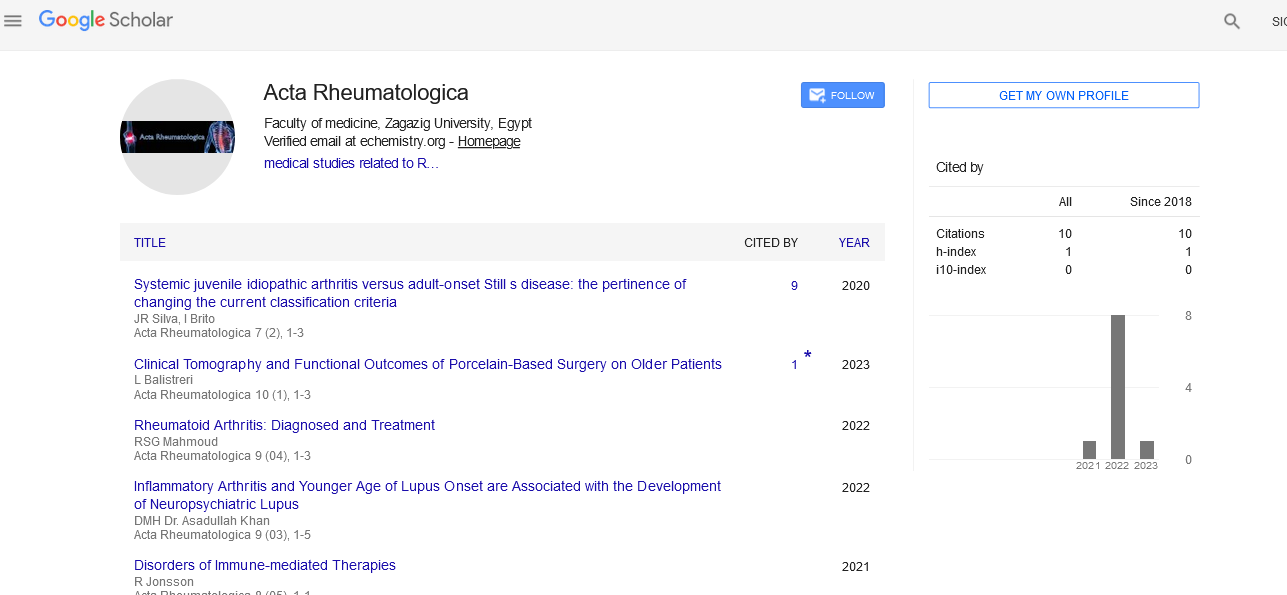Perspective - (2025) Volume 12, Issue 1
Corticosteroids: Mechanisms, Uses, and Health Implications
Sabrina Strano*
Department of Rheumatology, University College London, England
*Correspondence:
Sabrina Strano, Department of Rheumatology, University College London,
England,
Email:
Received: 06-Feb-2025, Manuscript No. IPAR-25-15557;
Editor assigned: 10-Feb-2025, Pre QC No. IPAR-25-15557 (PQ);
Reviewed: 25-Feb-2025, QC No. IPAR-25-15557;
Revised: 05-Mar-2025, Manuscript No. IPAR-25-15557 (R);
Published:
13-Mar-2025
Introduction
Corticosteroids are a class of steroid hormones that play a
critical role in regulating inflammation, immune response,
metabolism, and stress responses in the human body. They are
widely used in medicine for treating various conditions,
including autoimmune disorders, allergic reactions, respiratory
diseases, and skin conditions. While corticosteroids provide
significant therapeutic benefits, long-term use can lead to side
effects and health complications.
This article explores the mechanisms, classifications, clinical
applications, benefits, risks, and proper management of
corticosteroid therapy.
Description
Mechanism of action
Corticosteroids function by mimicking the effects of
hormones naturally produced by the adrenal glands. They
influence gene expression and protein synthesis, leading to
various physiological effects:
Anti-inflammatory effects: Suppress inflammatory responses
by inhibiting cytokine production and reducing immune cell
activity.
Immunosuppressive properties: Reduce immune system over
activity, making them effective in treating autoimmune
disorders.
Metabolic regulation: Affect carbohydrate, protein, and fat
metabolism, which can impact weight and energy balance.
Stress response: Help the body cope with stress by
influencing blood pressure and glucose levels.
Types of corticosteroids
Corticosteroids are broadly classified into two categories:
Glucocorticoids
These primarily regulate metabolism and immune response.
Common glucocorticoids include:
Prednisone: Used for autoimmune diseases, asthma, and
allergies.
Dexamethasone: Strong anti-inflammatory properties, used in
severe allergic reactions and COVID-19 treatment.
Hydrocortisone: Used for adrenal insufficiency and skin conditions.
Methylprednisolone: Commonly prescribed for severe
inflammation and neurological conditions.
Mineralocorticoids
These primarily control electrolyte balance and blood pressure. Common examples include:
Fludrocortisone: Used to treat Addison’s disease by
maintaining sodium and potassium balance.
Aldosterone: Regulates water and salt balance in the body.
Clinical applications of corticosteroids
Corticosteroids are used in various medical conditions due to
their broad effects on inflammation and immune function:
Autoimmune and inflammatory disorders
Corticosteroids are highly effective in managing autoimmune
conditions by suppressing excessive immune responses.
Conditions treated include:
• Rheumatoid arthritis
• Lupus erythematosus
• Multiple sclerosis
• Inflammatory bowel diseases (Crohn’s disease and
ulcerative colitis)
Respiratory conditions
Due to their anti-inflammatory effects, corticosteroids are
commonly used in respiratory disorders such as:
Asthma: Inhaled corticosteroids (e.g., budesonide, fluticasone)
reduce airway inflammation.
Chronic Obstructive Pulmonary Disease (COPD): Steroids help
reduce exacerbations and improve breathing.
Dermatological conditions
Topical corticosteroids are widely used to treat:
• Psoriasis
• Eczema
• Contact dermatitis
• Vitiligo
Allergic reactions
Corticosteroids effectively treat severe allergic conditions,
including:
• Anaphylaxis (in combination with epinephrine).
• Seasonal allergies (nasal sprays like fluticasone)
• Hives and angioedema.
Cancer treatment
Glucocorticoids like dexamethasone are used in cancer
therapy to:
• Reduce inflammation caused by tumors.
• Prevent chemotherapy-induced nausea and vomiting.
• Manage brain swelling in cases of brain tumors.
Neurological disorders
Corticosteroids help manage neurological conditions such as:
• Multiple sclerosis flare-ups.
• Spinal cord injuries.
• Brain edema following trauma.
Endocrine disorders
Corticosteroids are prescribed for adrenal gland disorders
such as:
• Addison’s disease (where the body does not produce enough
cortisol).
• Congenital adrenal hyperplasia.
Modes of administration
Corticosteroids can be administered through various routes,
depending on the condition being treated:
Oral (tablets, capsules): Used for systemic treatment of
inflammatory and autoimmune diseases.
Inhaled (aerosols, dry powders): Commonly used in asthma
and COPD.
Topical (creams, ointments, lotions): Applied to the skin for
dermatological conditions.
Injectable (intravenous, intramuscular, intra-articular): Used
for severe conditions requiring rapid effect.
Ophthalmic (eye drops, ointments): Used for eye
inflammation and allergic reactions.
Benefits of corticosteroids
Corticosteroids provide essential benefits in managing various
medical conditions:
• Rapid relief from inflammation and pain.
• Effective control of autoimmune and allergic diseases.
• Prevention of organ transplant rejection.
• Improvement of lung function in respiratory diseases.
• Reduced swelling in brain and spinal injuries.
Potential side effects and risks
Despite their benefits, corticosteroids can cause side effects,
particularly with long-term use. Common risks include:
Short-term side effects
• Increased blood sugar levels.
• Fluid retention and weight gain.
• Mood changes, anxiety, or depression.
• Increased appetite.
• Insomnia.
Long-term side effects
• Osteoporosis and bone fractures.
• Hypertension
• Cataracts and glaucoma.
• Muscle weakness.
• Adrenal suppression (reduced natural hormone production).
• Increased susceptibility to infections.
Strategies for safe corticosteroid use
To minimize risks, it is essential to follow guidelines for proper
corticosteroid use:
Lowest effective dose
Using the minimum effective dose for the shortest duration
reduces the risk of adverse effects.
Gradual tapering
Abrupt discontinuation of corticosteroids can cause adrenal
insufficiency. Physicians gradually reduce the dose to allow the
body to adjust.
Lifestyle modifications
• A healthy diet rich in calcium and vitamin D can reduce the risk
of osteoporosis.
• Regular exercise helps maintain bone density and muscle
strength.
• Blood pressure and glucose monitoring are essential for longterm
corticosteroid users.
Use of alternative therapies
Non-Steroidal Anti-Inflammatory Drugs (NSAIDs) and biologic
therapies may serve as alternatives to corticosteroids in some
conditions.
Conclusion
Corticosteroids are powerful medications with significant
therapeutic value in treating inflammatory, autoimmune, and
allergic conditions. However, their potential for side effects
necessitates careful management and adherence to medical
guidelines. By using corticosteroids judiciously, alongside
lifestyle modifications and regular medical supervision, patients
can benefit from their positive effects while minimizing health
risks. Continued research and advances in steroid-sparing
therapies may further enhance treatment options for various
conditions in the future.





